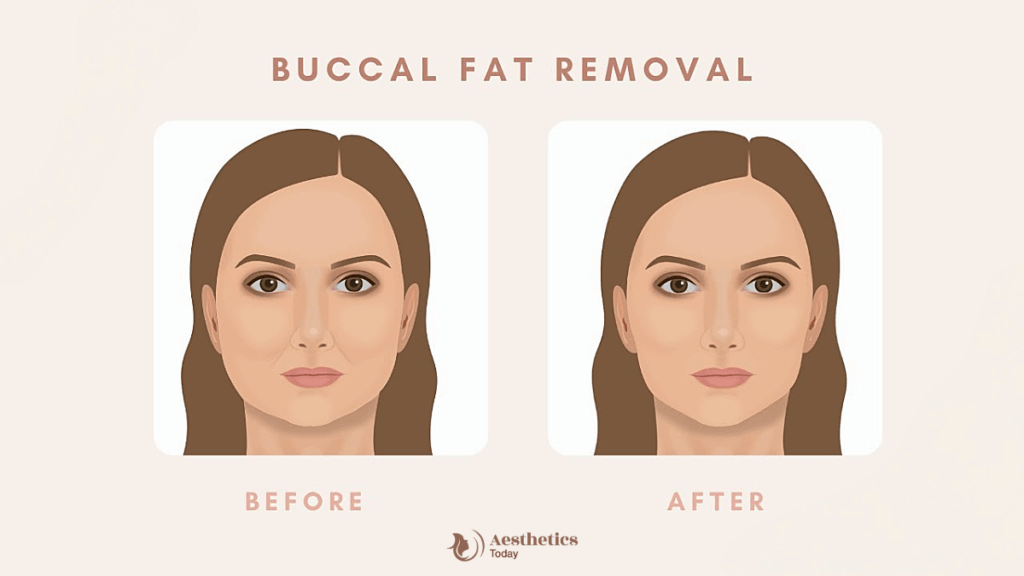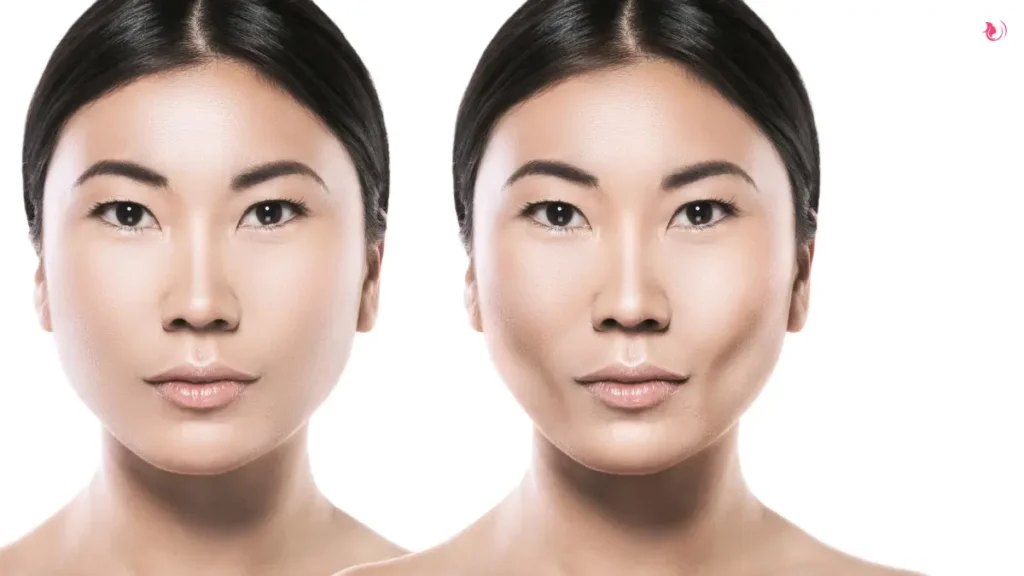Understanding Buccal Fat Removal
Buccal fat removal is the latest craze among celebrities. Also known as cheek reduction, is a specialised cosmetic surgery that targets the buccal fat pads in the face. These pads are located in the lower cheeks between the cheekbones and jawbones. The procedure is designed for individuals seeking a more sculpted facial appearance, emphasising the cheekbones and creating a defined contour between the cheeks and jawline.
Who Is It For?
Ideal candidates for buccal fat removal typically include people who feel that the fullness of their cheeks gives their face a rounder, less defined appearance. This procedure is often chosen by individuals who desire a more chiselled facial structure. It is particularly not recommended for individuals with naturally narrow faces or older adults, as the loss of buccal fat can lead to an overly gaunt appearance, especially as buccal fat naturally diminishes with age.
The Trend And Popularity Of Buccal Fat Removal
Buccal fat removal has gained significant traction in recent years, all thanks to social media and celebrity culture. Platforms like Instagram and TikTok have severely popularised the concept of achieving a “snatched” or sculpted look, where sharp cheekbones and a defined jawline are highly coveted. As influencers and beauty enthusiasts discuss the procedure, its allure has grown among individuals seeking a quick and impactful way to enhance their facial aesthetics.
Celebrities That Had It

Several celebrities have been speculated or confirmed to have undergone buccal fat removal. Among them, Chrissy Teigen has openly talked about having the procedure.
Others who are rumoured to have undergone buccal fat removal, based on changes in their facial features and expert opinions, include:
| Name | Name | Name |
|---|---|---|
| Khloe Kardashian | Megan Fox | Anya Taylor-Joy |
| Angelina Jolie | Lea Michele | Amelia Gray Hamlin |
| Liam Payne | Hailey Bieber | Emily Ratajkowski |
| Zoe Kravitz | Miley Cyrus | Dove Cameron |
It is important to note that while some of these speculations are based on the observations of plastic surgeons, not all celebrities have publicly confirmed undergoing this procedure.
The Procedure Explained

Buccal fat removal is a delicate procedure that requires the expertise of a licensed plastic surgeon. It can be performed in a hospital or a surgeon’s office and usually allows patients to return home the same day.
Before The Surgery
Before the surgery, a detailed consultation with the surgeon is needed. This involves discussing the desired outcomes, understanding the procedure, and addressing any health conditions or medications that might affect the surgery. For those who smoke, it is advised to quit, as smoking can hinder healing and the final aesthetic results.
During The Surgery
The procedure typically takes about 45 minutes and involves the following steps:
- Anaesthesia: The patient receives local anaesthesia to numb the face. If undergoing multiple procedures simultaneously, general anaesthesia may be administered.
- Making Incisions: The surgeon makes small incisions inside the mouth, on both sides of the face, to access the buccal fat pads.
- Removing Buccal Fat: The buccal fat pads are exposed, and carefully extracted to the desired amount, and the incisions are closed with sutures, often dissolvable.
- Completing the Procedure: The process is repeated on the other cheek to ensure symmetry.
Post-Procedure Care And Recovery
Recovery from buccal fat removal typically takes about three weeks, but the final results may take longer to manifest as the face adjusts to the change. After the surgery, patients are usually given instructions on caring for the incisions, typically involving a special mouth rinse to aid healing and prevent infection. A liquid diet is recommended for the first few days, gradually transitioning to soft foods.
Patients may experience swelling, bruising, and numbness around the incision sites, which should subside as the healing progresses. It’s advisable to plan for a week off from work and normal activities to recover comfortably.
The results of buccal fat removal are long-lasting, as the removed fat pads do not grow back. However, other fat cells in the face may expand with significant weight gain. The final face shape should be stable unless substantial weight changes occur. For this reason it is always important to consider a healthy lifestyle and a balanced diet after undergoing the procedure.
Risks & Considerations
Buccal fat removal is considered a relatively safe procedure. However, like any surgical procedure, buccal fat removal comes with its set of risks and potential side effects, including infection at the incision site, injury to facial nerves or salivary ducts, asymmetry or uneven contouring of the face, and the potential for a prematurely aged appearance if too much fat is removed. If we look at the numbers, a 2024 review of 308 patients found that about 1 in 4 people (25%) experienced some kind of complication after buccal fat removal. The most common problems were swelling (38%), difficulty opening the mouth (30%), pain (19%), and uneven results (12%). Serious issues like nerve damage or infection were very rare, less than 1% of cases.
Therefore, selecting an experienced and skilled surgeon is crucial for minimising these risks and achieving the desired aesthetic results, as a qualified surgeon can assess individual facial structures and tailor the procedure accordingly.
Places such as 111 Harley St. clinic in London offer buccal fat removal in a safe environment by a highly experienced surgeon. Dr Ayad Harb and Dr Nizar Hamadeh also offer excellent services in their respective clinics.
The Decision-Making Process
Deciding to undergo buccal fat removal is a deeply personal choice. It is essential to consider the desired aesthetic goals, understand the potential benefits and risks, and have realistic expectations of the outcomes. Consulting with a plastic surgeon can provide valuable insights and help in making an informed decision.
Most doctors recommend waiting until ages 18 to 20 before considering buccal fat removal, as the face and buccal fat pads continue to mature into early adulthood. Older adults may need additional procedures, such as a face-lift, to address skin elasticity issues and prevent sagging in the lower face post-surgery.
Buccal Fat Removal Cost
The cost of buccal fat removal can vary widely depending on factors like geographic location, surgeon’s expertise, and associated surgical costs. As it is a cosmetic procedure, it is generally not covered by medical insurance. Patients should discuss all potential costs with their surgeon to avoid unexpected expenses.
Buccal fat removal is a targeted cosmetic procedure that can significantly enhance facial contours. With careful consideration, expert surgical execution, and proper post-operative care, patients can achieve a more sculpted and defined facial appearance.
Endnotes
Buccal fat removal has emerged as a sought-after cosmetic procedure, offering individuals the opportunity to enhance their facial contours and achieve a more sculpted appearance. While it can deliver transformative results, it is essential to approach the decision with a clear understanding of the procedure, its benefits, and its potential risks.
Consulting with a qualified plastic surgeon is a crucial step in ensuring a tailored approach that aligns with individual aesthetic goals and facial anatomy. By doing so, patients can make informed choices and enjoy the confidence that comes with their enhanced features.



1 Comment
I always thought that all these celebrities looked amazing with their pronounced cheeks. Now I know how they do it. Amazing.